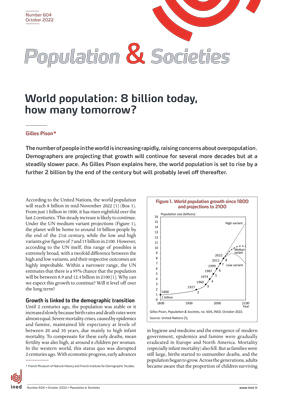World population: 8 billion today, how many tomorrow?
Press release Published on 16 October 2022

Author: Gilles Pison
According to the United Nations, the world population will cross the threshold of 8 billion on 15 November 2022. It numbered only one billion in 1800 and has therefore increased eightfold over the last 200 years. It should continue to grow and could reach around 10 billion by the end of the 21st century. Should growth continue? Is stabilization possible in the long term?
If the world population continues to increase, it is due to the excess of births over deaths – the former are twice as numerous as the latter. This excess began two centuries ago in Europe and North America when mortality began to decline in those regions. It then spread to the rest of the planet when advances in hygiene and medicine and socio-economic progress affected other continents.
Fertility has halved since 1950
Today, population growth is decelerating. It reached a maximum of more than 2% per year 60 years ago and has since halved (1% in 2022). It should continue to fall in the coming decades due to the decline in fertility: on average 2.3 children per woman in the world today, compared to more than double (5 children) in 1950. The world’s regions where fertility is still high—above 2.5 children per woman—include practically all of Africa, some countries of the Middle East, and a part of Asia stretching from Kazakhstan to Afghanistan and Pakistan. This is where most of the world’s population growth will be in the future.
One in four people will be living in Africa in 2050
One of the major demographic features of future decades will be the considerable population growth in Africa. Under the UN medium projection, the continent’s population, including that of North Africa, could almost triple by the end of the century, rising from 1.4 billion inhabitants in 2022 to 3.9 billion in 2100. While 1 person in 6 currently lives in Africa, the proportion will probably be 1 in 4 in 2050 and perhaps above 1 in 3 in 2100. Growth should be especially rapid in sub-Saharan Africa, where, under this same scenario, the population is set to rise from 1.2 billion in 2022 to almost 3.4 billion in 2100.
Published on: 18/10/2022








